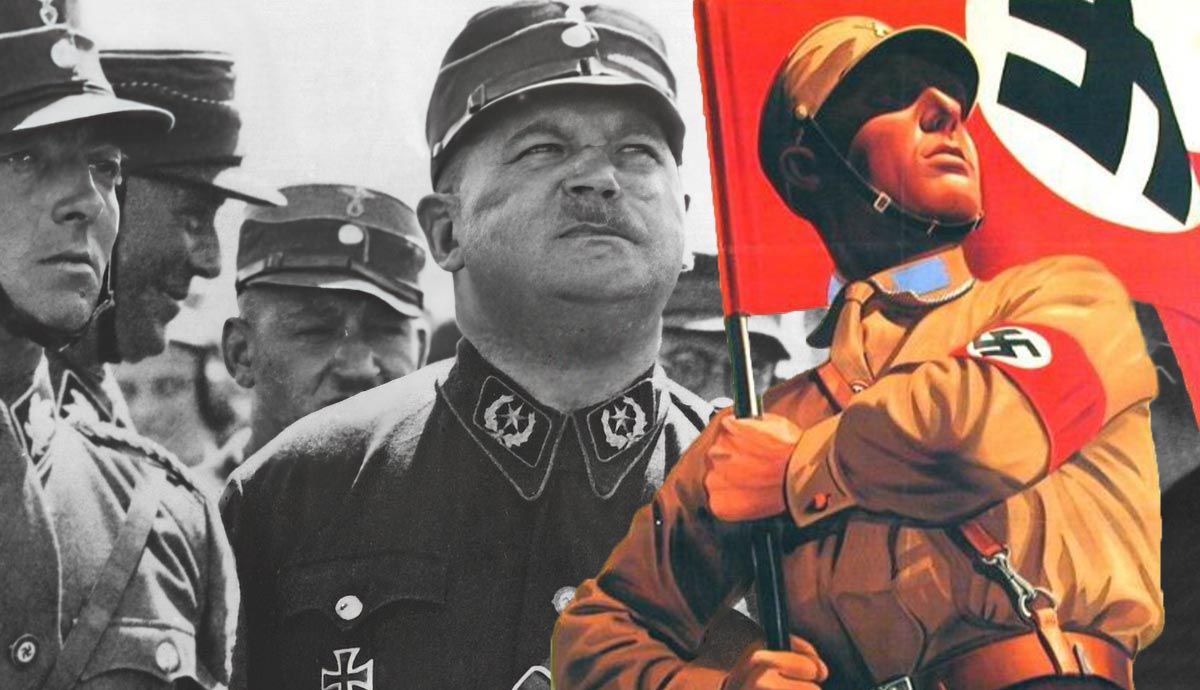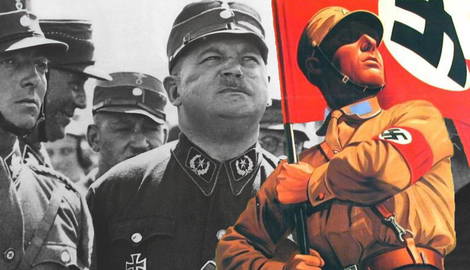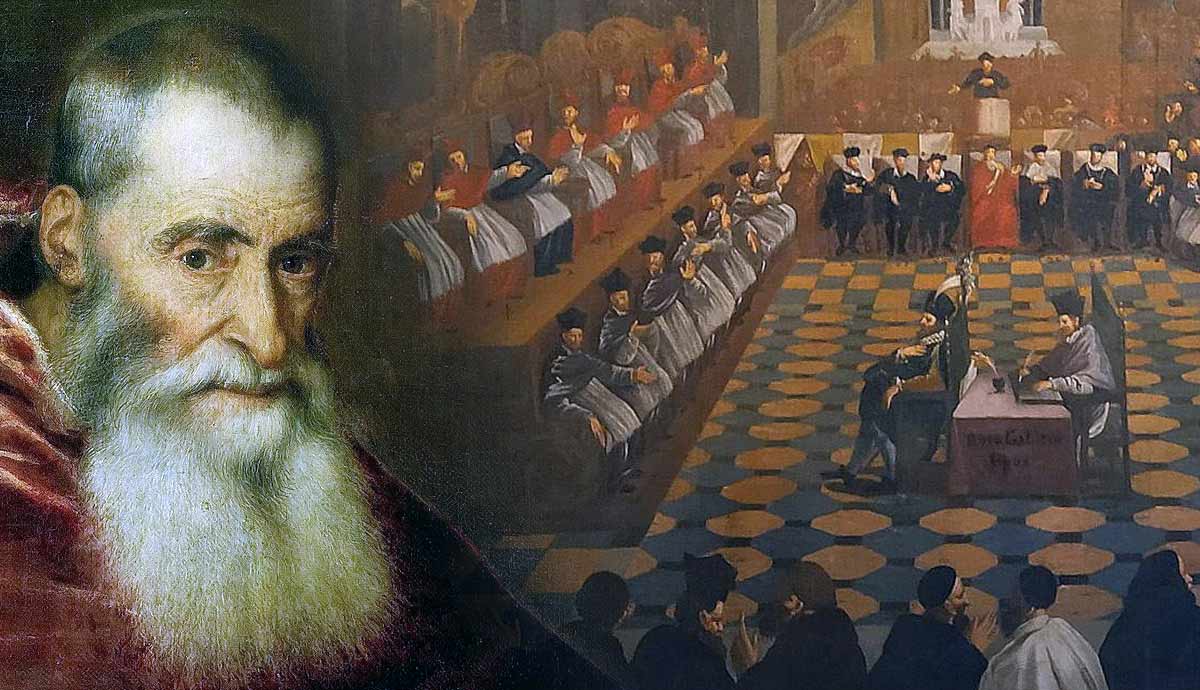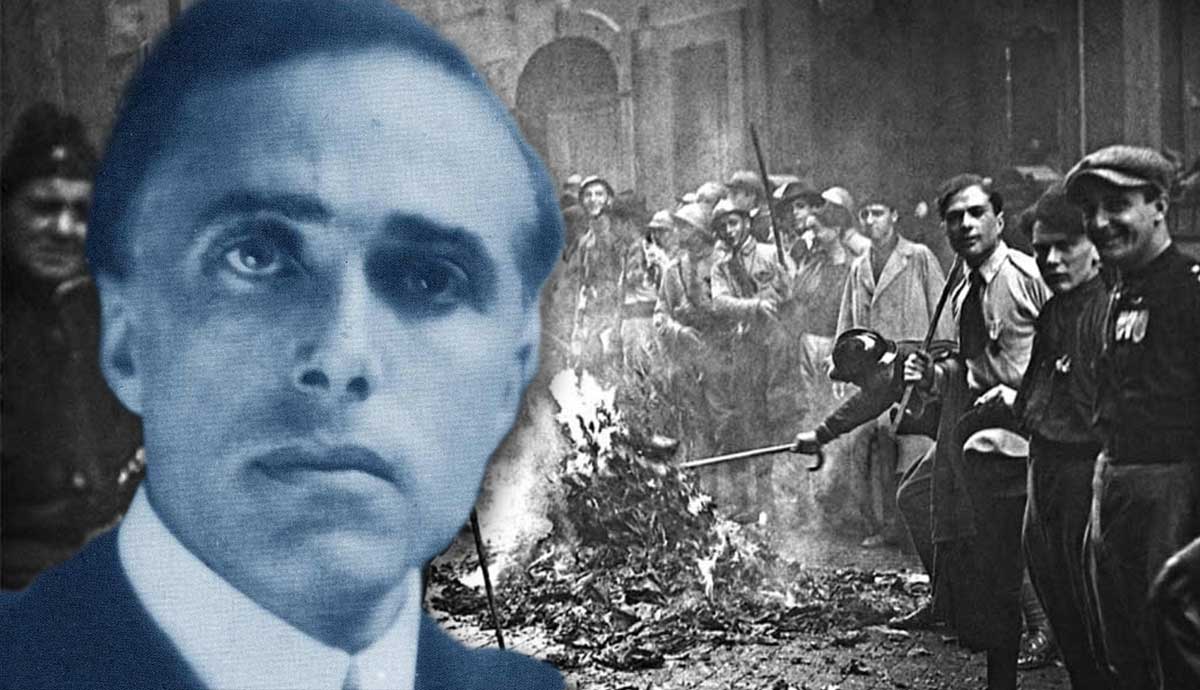
On July 3, 1934, the Nazi Party newspaper Völkisch Beobachter ran the following headline: “The Reich President to the Führer, The German People Saved from Serious Danger.”
Between June 30 and July 2, the SS and the Gestapo carried out a string of political murders to purge the Nazi party from the Sturmabteilung (SA) and other conservative opponents. From the 1920s, the SA, led by Ernst Röhm, had helped Adolf Hitler gain power. By 1934, however, the Assault Unit’s unruliness had become a source of concern. The bloody purge, known as The Night of the Long Knives, was a turning point in the history of the Third Reich.
A Second Nazi Revolution? The Origins of the Night of the Long Knives

On the night of February 27, 1933, almost one month after Adolf Hitler’s appointment as Reich Chancellor, the Reichstag was destroyed by a fire. When the German Parliament building burnt down, the Nazi party was engrossed with the final stretch of the election campaign. In the general hysteria and panic that followed, Hermann Goering claimed the Communists had lit the fire in an attempt to overthrow the Weimar Republic.
In the weeks after the Reichstag Fire, members of the Sturmabteilung (the NSDAP’s Assault Division) arrested, imprisoned, and tortured thousands of German communists and other political opponents. The Emergency Decree for the Protection of the German People, signed by President Hindenburg the day after the fire, provided the Nazi party with the legal basis for the violent campaign.

On March 23, 1933, Adolf Hitler managed to secure the passage of the so-called Enabling Act, a law allowing him to issue decrees without the previous approval of the parliament and the president. Having finally obtained virtually absolute powers, Hitler began the Gleichschaltung (coordination), a “revolutionary” process of ideological realignment and structural reorganization of the country’s economic, political, social, and cultural life.
With a series of decrees, Hitler deconstructed and rebuilt the system of regional government, the civil service, and the labor unions organization. Finally, on July 14, 1933, the NSDAP officially became the only legal German political party.

However, in the summer of 1933, Adolf Hitler began to decelerate the process of Gleichschaltung in favor of a policy of stabilization. While the National Socialist Revolution allowed him to exercise almost total control of the country, the demands of the more radical fringes of the party alarmed the armed forces’ leadership, the industrialists, and financiers.
In particular, the traditional elites firmly opposed Ernst Röhm’s repeated calls for a Zweite Revolution (Second Revolution) to replace the capitalist economic system. However, Adolf Hitler, who sought to succeed the ailing Paul von Hindenburg as Reich President, needed the support of the country’s traditional authorities.
From Private Army to “Agent of Chaos”: Ernst Röhm’s SA

While its leaders protested Hitler’s decision to end the Nazi revolution, the Sturmabteilung had played a crucial role in the NSDAP’s rise to power. Initially composed of World War I veterans frustrated with the Versailles Treaty, the SA steadily increased its membership, especially among the younger generations. By mid-1934, under Röhm’s leadership, the Assault Division had become a mass organization with around 4.5 million members.
In the previous decades, the SA men, also dubbed Brownshirts, served as a self-protection division for the Nazi party. Their main task, however, was to harass and intimidate political opponents. Clad in their brown-colored uniforms, the members of the Sturmabteilung had also been instrumental in spreading and violently enforcing the Nazi party’s anti-Semitic rhetoric in the streets, schools, and universities.
In 1923, the SA assisted Hitler with the Beer Hall Putsch, a failed attempt to overthrow the government. After Hitler’s appointment as chancellor, Röhm’s men played a crucial role in the process of Gleichschlatung of Germany’s society.

When Hitler aimed to win the support of the traditional right-wing elitist groups, however, the thuggish behavior and unchecked violence of the SA became a liability. Most importantly, the Reichswehr’s generals strongly disapproved of Röhm’s plan to absorb the regular army into the SA to form a Volksmiliz, a military organization Röhm envisioned as the country’s sole armed force.
In December 1933, when Hitler appointed the leader of the SA as minister without portfolio, Röhm sought to gain influence in the regime. As he doubled the calls for a “Second Revolution,” his followers dubbed him Willensträger der nationalsozialistischen Revolution (moving force of the National Socialist revolution).
Between 1933 and 1934, the internal conflict dividing the NSDAP into two opposing groups was not based solely on ideological differences. Several long-time SA members resented that better-educated upper-class newcomers had used their political affiliations to advance their careers. In the spring of 1934, as the Sturmabteilung’s street violence and volatile behavior began to alienate President Hindenburg and the traditional elites, Hitler started to consider the party’s Assault Division as a hindrance in his plan for total control.
Adolf Hitler vs. Franz von Papen

On June 17, 1934, at Marburg University, Franz von Papen, the German Vice-Chancellor, held a speech publicly denouncing Röhm’s “Second Revolution” and the erratic conduct of the SA:
“No people can afford constant revolt from below if it wants to survive the court of history. At some point the movement will have to end, and a fixed social structure, held together by an independent justice system and a universally accepted power of state, must come into existence.”
While von Papen and his group of Jungkonservativen (neoconservatives) had previously called for the establishment of an authoritarian state, they objected to the more radical aspects of the Nazi movement. In particular, they held the thuggish methods of the SA in contempt.
Franz von Papen’s Marburg speech, as William E. Dodd, the US Ambassador in Berlin, reported to the Secretary of State on June 26, “aroused the bitter opposition of the more radical elements of the Party, such as Goebbels and Rosenberg. Even Hitler himself is said to be greatly disturbed.”
The Minister of Propaganda, Joseph Goebbels, even prohibited any German newspaper from printing the full text of the vice-chancellor’s critical address. Von Papen’s attack against the Nazi party’s Sturmabteilung alarmed Hitler, who was set on maintaining an illusion of democracy to endorse a policy of cordial relationship with the state’s elites.
By the time Ambassador Dodd compiled his report, Hitler had already met President Hindenburg, who shared von Papen’s apprehension. During the meeting, Werner von Blomberg, the Minister of Defense, warned the Nazi leader that if he failed to curb the radical fringes of the NSDAP, he would place the country under martial law. Hitler, who had previously refrained from openly taking sides in the party’s conflict, finally decided to eliminate the troublesome SA and its leaders.
Massacre at Bad Wiessee: The Röhm Purge

On June 29, 1934, Adolf Hitler, who was in Essen with Goering to attend the wedding of Gauleiter Josef Terboven, ordered Röhm to assemble the leaders of the SA in Bad Wiessee (Bavaria), where he would later join them. In the previous days, Heinrich Himmler and Hermann Goering, two of Röhm’s fiercest critics, had warned the party of an alleged imminent putsch organized by the SA’s Chief of Staff. As a result, Himmler’s Schutzstaffel and the Sicherheitsdienst (Security Service) had begun to plan the purge of Röhm’s followers, secretly dubbed “Operation Hummingbird.”
In the early hours of June 30, Hitler flew to Munich, where he learned of an alleged protest carried out by the city’s SA members. Thus, he summoned the local division’s leaders to the Innenministerium, where he stripped them of their medals, attacking them as “traitors.” From Munich, Hitler traveled to Bad Wiessee. There, he ordered the SS to break into Hotel Hanselbauer, where the SA leaders were still sleeping.
In 1954, Erich Kempka, Hitler’s chauffeur, gave a detailed account of the Night of the Long Knives. The Brownshirts arrested at Bad Wiessee were later executed at the Stadelheim prison in Munich. Ernst Röhm, forced to choose between suicide or execution, was shot on July 1, 1934. Hitler had previously considered pardoning him. The bloody purge continued until July 2. According to the most recent estimates, around 1,500-2,000 SA men were murdered.

While the SS arrested the Sturmabteilung’s leaders in the Bavarian spa town, Goering launched a state-wide parallel purge of all conservative opponents of the Nazi party. The Gestapo and the SD had previously compiled meticulous lists of prominent Hitler’s critics. German author Thomas Mann claimed that “Operation Hummingbird” was an opportunity to cover up the Nazi involvement in the Reichstag fire.
Some of them were shot in their offices and homes. Others were executed in the Gestapo headquarters. The victims of this bloody operation included former Chancellor Kurt von Schleicher, along with his wife, and Generalmajor Ferdinand von Bredow. Franz von Papen, placed under house arrest, survived the purge. However, his aides, Herbert von Bose and Edgar Jung, were killed.
The Aftermath of the Night of the Long Knives

In the immediate days after the string of political killings, the Nazi party publicly portrayed the purge as a necessary preemptive action to avoid the so-called “Röhm Putsch” from disrupting the country’s stability. On July 3, 1934, the government issued the Staatsnotwehrgesetz (Law of State Self-Defense), a decree legalizing the violent elimination of political opponents as an emergency measure to thwart the SA’a imminent coup d’état.
Joseph Goebbels, who coordinated the party’s campaign to justify the murders, repeatedly emphasized Röhm’s homosexuality to depict the Sturmabteilung as a “degenerate” organization. It was not the first time the press referred to the SA leader’s sexual orientation to attack him. In 1931, for example, the socialist newspaper Münchener Post had denounced Röhm’s “homosexual activities.” In 1932, Röhm’s intimate letters to a physician were leaked to the press.
While the Nazi party had previously tolerated the SA leader’s sexuality, the Minister of Propaganda exploited the societal condemning view of homosexuality to legitimize the purge. On June 30, 1934, after the mass arrests at Bad Wiessee, the Reich Press Office stated that the event:
“revealed images morally so sad that the slightest grain of sympathy had to vanish. A number of the SA leaders present had taken toy boys along, and one had to be woken and arrested in the most despicable situation. The Führer ordered the uncompromising extermination of this pestilential bulb.”
Several newspapers published similar colorful accounts of the Night of the Long Knives.
The Night of the Long Knives as a Key Event in the Third Reich

The wave of political murders of the summer of 1934 helped Hitler secure the desired support of the Reichswehr leadership. Thus, on August 2, after Hindenburg’s death, the Nazi leader merged the offices of chancellor and president and became Füher und Reichskanzler of Germany. After Hitler obtained complete control of the country, the Reichswehr replaced its previous oath to the Weimar Constitution with the so-called Führer Oath, a personal pledge of loyalty to Hitler. From 1935, the Third Reich’s armed forces, renamed Wehrmacht, underwent a process of remilitarization.

Besides cementing Hitler’s position of power, the Night of the Long Knives led to crucial long-term consequences. On July 13, 1934, in a radio broadcast from the Reichstag, Hitler presented himself as the “highest judge of the German volk.” On August 2, in an article titled “The Führer Protects the Reich,” Carl Schmitt, at the time the most prominent Nazi jurist, echoed Hitler’s claim, stating that as “highest judge,” Hitler “defend[ed] the law from the most fatal abuse if, at a moment of danger, he creat[ed] unmediated justice.”
In The Dual State, German-Jewish lawyer Ernst Fraenkel introduced the concepts of “prerogative state” and “normative state” to explain the coexistence of “unlimited arbitrariness and violence” with the rules and regulations of the law.










